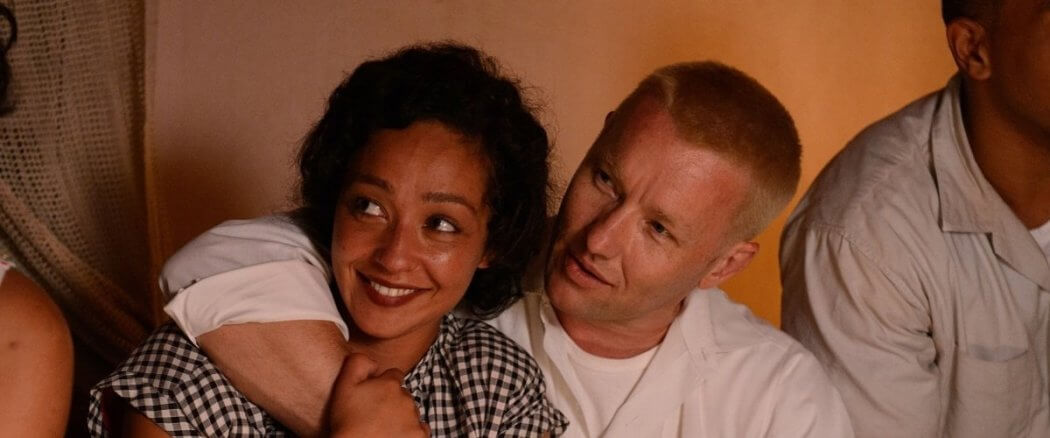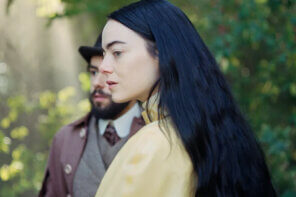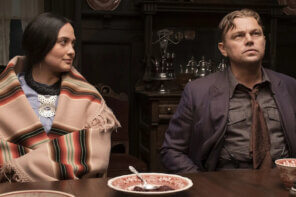When I was reared in rural Indiana in the 1950’s, I never saw living (as opposed to pictures) people of color other than on those rare occasions my brothers, sisters, and I piled into our (usually beaten up) car and made the annual (or in a good year, semi-annual) trek into Fort Wayne (50 miles from our farm). I was lucky, as I can never remember my parents saying a single derogatory word about people of other races and colors, despite my long 5-year-old stares at them out of the back window of our vehicle — wondering why they looked so different. My parents never discussed politics around me (I think they were too busy just putting food on the table for my seven siblings and me), and I never heard the “N word” in my home. At school, we had a few Latinos as classmates but I do not remember any abuse directed toward them. The meanest among my classmates picked on Amish kids — calling them names and generally making them suffer for being different. They were our chosen minority to persecute. But one thing everyone I knew agreed on was that a white person who dated or married a black person (then a “negro” at best) was doing something very wrong — so wrong it had to be a sin. I grew up quite sure that miscegenation was against God’s will — and everyone I knew felt that way too.
A Forbidden Marriage
Loving starts in 1958 by introducing Richard Loving, a white 25-year-old construction worker, and a 19-year-old woman of color, Mildred Jeter. We see them at gatherings of young people racing cars or drinking. What is unusual is that we see Richard socializing almost exclusively with other people of color and both seem unfazed by each other’s race. Richard and Mildred almost always have their arms about each other or their hands clasped. The portrayal of their mutual affection is completely convincing. Mildred becomes pregnant out of wedlock and Richard wants to marry her. He takes her to a plot of land he has purchased which overlooks verdant fields and woods, and to her surprise tells Mildred he has bought this parcel of land and that this is where he will build their home. Despite some misgivings on her part (and Richard’s mother), they decide to make the 90 mile trek to the District of Columbia to be legally married. This was necessary as in Virginia, since 1662, marriages between “whites” and “non-whites” were banned by law (along with, at that time, 24 other states).
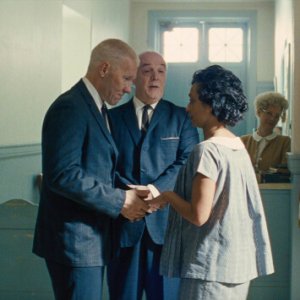
As shown in this based-on-fact movie, 5 weeks after their return while sleeping in the same bed in Mildred’s parent’s humble home and with their marriage license hanging on their bedroom wall, the county sheriff and his deputies broke into their home and dragged them out of bed. When Mildred (always by far the most verbal of the two) pointed to the marriage license and protested saying “We are legally married” the sheriff notoriously answered “Not in this state you ain’t.” Richard stayed in the decrepit jail overnight but Mildred, who was in the last trimester of their pregnancy, was left incarcerated for almost a week with Richard not allowed to post bail.
When their case came before the local court, the Lovings pled guilty on the advice of their local attorney hoping for the court’s mercy. Instead of understanding, Judge Leon Bazile convicted them on felony charges. They both received a sentence of one year which would be suspended only if they left the state for 25 years (or agreed to divorce). Bazile later wrote (in denying an appeal of the harsh sentence) “Almighty God created the races white, black, yellow, malay, and red, and he placed them on separate continents. The fact that he separated the races shows that he did not intend for the races to mix.”
The Legal Issues
The film follows the couple through their years of alternately attempting to abide by the court’s decision versus quietly defying the ruling by sneaking back into Virginia. Ultimately Richard and Mildred (especially) found living in and rearing their family in Washington D.C. to be intolerable for a family who yearned for their country roots. So they took an unusual step which surprisingly led to their enlisting the support of the ACLU and fighting the Virginia law of which they were convicted, and more importantly the very concept that our governments had a right to tell its citizens who they should and should not marry. The final decision on the case, made by the US Supreme Court, did not come until June 12, 1967 (known as “Loving Day”). While effectively ending miscegenation laws across the country, some (mostly Southern) states kept the laws on their books until the turn of the last century even while realizing they could not be enforced. Alabama finally removed its version of the law in 2000 when 60% of its voters endorsed a ballot initiative to do so. (To see how the case was featured contemporaneously — with rather dated commentary — on ABC go here.)
Obviously this is a fight that continues to be pertinent very recently regarding the prohibition of same-sex marriages. The US Supreme Court cited the Loving case repeatedly in its 2015 Obergefell v. Hodges case which finally settled the same-sex issue, using the same principles in its decision – that all Americans had the right to equality which included an “unenumerated right to marriage.” Today most of us (even those who are old like me) do not give interracial couples a second thought and I have several such unions in my conservative family. Part of the credit (perhaps a lot of the credit) goes back to this unassuming couple.
A Love Poem
So what about the movie? Do we see a court-room drama of high intensity, where we hang on the testimony of the defendants and the oratorical skills of the attorneys? Do we see a movie of violence against people of color, and of hatred spewed out towards those who are different? No… we have the pleasure of seeing two people whose every gesture, facial expression, and word (and those are sparse) communicates their eponymous relationship. They rarely are seen to “bite” at each other despite the stress of their lives. They are surrounded by mostly kind and supportive family and friends. They are simple people who wish to simply live their lives together. They were, at the time, uninterested in setting legal precedent or changing anything other than their ability to live without harassment in the community where they were reared.
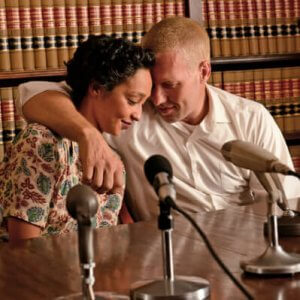
Richard Loving is played by Joel Edgerton (Black Mass) and is absolutely convincing in his role of a man who lives simply and feels no need to for extra verbiage. Edgerton completely convinces you of the time and place the story takes place, and would fit unnoticed in the hardware store, garage, or bar of the small village where I reside. Likewise his opposite lead, Ethiopian born Ruth Negga in her first major role, is astounding as Mildred. Having the look that goes along with Mildred (in real life) being half Native American, her eyes are incredibly expressive and her sparse dialogue so well delivered that one is certain she is Mildred. The two play off each other as a real couple where one is certain they love each other selflessly and will do so forever. When Richard’s friends ask him why he does not just solve the “problem” by divorcing Mildred but continuing to live with her if he wanted, his stare of scorn is perfect. In the film one watches scene after scene of Negga and Edgerton interacting with amazement at how convincingly “in love” their characters are portrayed. They both deserve the honors coming their way this awards season.
As for the narrative, it is heartfelt in its understated way. But director/screenwriter Jeff Nichols (Mud and Midnight Special) failed to put much dramatic tension in the narrative. There is no background — how did the couple meet? Why is Richard Loving so well accepted in the black community? Were there no repercussions among the white people with whom he worked (only one mild event is shown)? Why is the fact that crosses were burned in the yards of the Lovings and Mildred’s parents not part of the narrative? The film’s plot unfolds in straightforward fashion and there are periods where very little is happening. Some of the events which are meant to be turning points in the narrative were, to me, unconvincing. And the scenes in front of the Supreme Court, which should have been the climax of the film, are portrayed with a blurred view of the bench and justices — a big mistake I think. I missed the pleasure of seeing, for dramatic effect if nothing else, the interplay between the attorneys and justices and the expressions on their faces as they heard the arguments and their replies and questions. (OK, I am kind of a legal nerd. Too much Perry Mason when I grew up.) And if you are also a legal nerd, you can hear all 2 hours plus of the legal arguments here.
The Loving Story
Jeff Nichols admits the movie is based on The Loving Story, a wonderful 2011 documentary I first saw at the Traverse City Film Festival. The director, who was present in Traverse City for a Q&A, is Nancy Buirski and she deserves credit for first revealing the full story of the Lovings. See a wonderful interview with Nancy here which includes examples of the “found” 16 mm film footage of the Loving family featured in the documentary. As noted in the interview, The Loving Story documentary was also beautifully supplemented by photos taken for the iconic magazine Life in 1966. The photographer, Grey Villet (a small role played by Michael Shannon in the Loving movie) took heart-warming black and white photos of the Lovings and their three children as they were awaiting a final determination of their case (you can see ten of the pictures here). The family’s unmistakable love for each other is easily evident.
Beyond short interviews where Richard, especially, was obviously uncomfortable in front of the camera, The Loving Story benefited from interviews of the two ACLU attorneys who defended them, Bernie Cohen and Philip Hirschkop. They gave testimony to the sincerity of the Lovings and their disdain for any publicity or adulation, even after understanding the enormous importance of their case. One thing that is interesting after seeing both films is the incredible physical resemblances of the actors in Loving and their real-life characters. (To avoid any confusion, there was also a TV movie made of this story in 1996 titled Mr. and Mrs. Loving but Mildred Loving has said that almost nothing portrayed in that movie was factual so I would avoid it.)
Love Is Not a Thing to Be Laid Aside
The rest of the Lovings’ lives were not without difficulties. Richard died and Mildred was severely injured (losing one eye) when their vehicle was hit by a drunk driver eight years after the Supreme Court decision. Two of their three children died before their mother. However Mildred Loving remained resolute in her love for Richard up to her death from pneumonia in 2008. But their lives’ signatory event, which flowed from their steadfast love for each other, will serve as inspiration for many of us.
If you love stories of justice for the common person, if you love stories reminding you of the progress (slow but real) America has made in overcoming its “original sin,” if you love memorable characters portrayed by great actors… if you want to see beautiful cinematography of rural Virginia… if you want to see the basis of the recent legalization of same-sex marriage… then see this movie. Better yet, see the documentary The Loving Story (available from several different streaming services at minimal cost) which I would give a solid “A”. No matter which film you see, you will find what at heart is really just a love story… a story where people refuse to take the easy way out and stand fast for what they believe. As Charles Dickens wrote:
Love is not a feeling to pass away,
Like the balmy breath of a summer day;
It is not — it cannot be — laid aside;
It is not a thing to forget or hide.
Richard and Mildred Loving are asked by their attorneys to go with them to appear before the US Supreme Court, telling them it is a rare honor. But Richard, as we would expect and with Mildred following his lead, declines. His attorneys then ask Mr. Loving if he has anything he wants his attorneys to say to the justices. “Yeah” Richard quietly replies. “Tell the judge I love my wife.” And that is truly what their story is all about.

